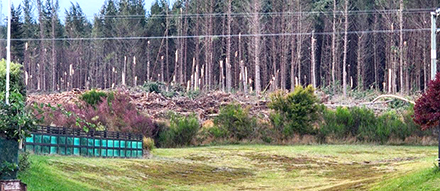A collaborative project has arisen from the aftermath of Cyclone Gabrielle, which aims to build Northland’s resilience to future adverse weather events by tackling the problem of fallen and at-risk trees. Source: Timberbiz
The NZ$6.5 million project, Ngā Manga Atawhai, pulls together groups from across government, councils, iwi, and the private sector to enable the removal of dangerous trees, while ensuring the majority of the wood doesn’t go to waste, by processing it and providing it to low-income whānau as firewood to warm their homes.
Northland Civil Defence Emergency Management Group Chair Kelly Stratford says that many of the issues Northlanders experienced from Cyclone Gabrielle were due to fallen trees.
“After Gabrielle we saw 64,000 Northlanders without power, the largest outage our power network has ever seen and most of those outages weren’t due to network issues, they were due to trees that had fallen onto powerlines,” she said.
The impact of these outages was felt by many Northlanders, with some areas having outages for two weeks or more.
Apart from the impacts on food storage, cooking, and heating, the loss of power also took out much of the phone network severely limiting Northland’s communications.
The impacts to Te Taitokerau from fallen trees didn’t stop there. Tree falls also caused issues on the region’s roads, with Northland’s three district councils reporting over 900 combined call outs in relation to fallen trees impacting local roads post Cyclone Gabrielle.
Ms Stratford says that even though the power companies and roading agencies did an amazing job restoring these services, there is still work to be done when it comes to problem trees.
“Even though the immediate work has been done, hundreds of trees remain fallen under existing powerlines or next to roads and rivers, and thousands of standing trees remain at risk of falling over our roads, rivers, and powerlines – that’s why this kaupapa is so important,” she said.
She also emphasized that only trees that have already fallen or are causing a risk to powerlines or other infrastructure are being targeted by the project.
Ms Stratford said the idea for the project came out of the Northland Civil Defence Emergency Management’s community consultation for Cyclone Gabrielle recovery where many people spoke of the effects of being without power for an extended period.
“At this time, the recovery efforts in Northland were also seeing the great success of the Enhanced Task Force Green project, which is funded by Ministry of Social Development, and delivered on-ground by Te Roroa. Much of their work involved processing downed trees for our rural communities,” Ms Strathford said.
“Then, we started hearing about more trees that had been left by roadsides and were down in rivers. It made sense to bundle this up into one project, to process trees near powerlines, roads, and rivers, and make the wood available to low-income whānau for free.”
Te Roroa will lead on-the-ground delivery of the project, with NZ$1 million of funding secured from the Ministry for Primary industries to get things underway, with more funding sought from central government.
The model is based on a portion of the firewood being sold commercially for the first two years, with the majority being given away to low-income whanau, after that, the project should be self-funded.
The initial on-the-ground work will focus on processing trees already removed by Northland Regional Council from 70 locations across 25 rivers around Northland.






